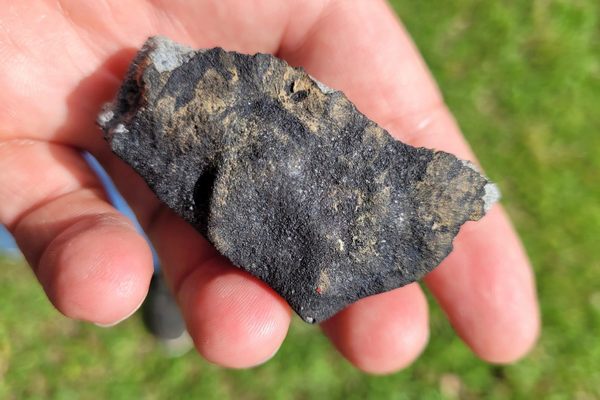Asteroid 2024 RW1 Just Hit Earth. That’s a Good Thing.
The asteroid that exploded over Luzon was not a threat—but it was a victory for our planetary defense systems.

In the very early hours of Sept. 4, Jacqueline Fazekas, a researcher at the NASA-funded Catalina Sky Survey in Arizona, spotted something moving in a suspicious arc across the sky. She quickly submitted her observations to the Minor Planet Center in Massachusetts. The database, available to the public and constantly updated, keeps track of, among other objects, the solar system’s known asteroids and comets. Within moments of the observations posting, other astronomers were also pointing their telescopes at the fuzzy dot.
What happened as the day unspooled was a small but important victory for science and the planet.
That fuzzy dot Fazekas spotted was, as you’ve probably guessed, an Earthbound asteroid. It was a veritable pipsqueak, just three to five feet long. There was almost zero possibility of it causing even minor damage. It was, in effect, an overgrown shooting star. Dubbed 2024 RW1, the rocky projectile burned up at 16:39 UTC in the skies above Luzon Island, in the Philippines, as a beautiful, blue-green fiery streak.
Earth gets hit by small asteroids pretty frequently. Just this year, several rocky wanderers from afar have been caught disintegrating above our heads, including a small asteroid that flamed out above New York City in July. In May, a comet’s icy shard could be seen burning up above Spain and Portugal as it plunged into the atmosphere at 100,000 miles per hour.
The point, really, is that our planet is in the path of a never-ending firing line of minuscule rocky asteroids and cometary fragments. Like 2024 RW1, they pose no harm. But RW1’s impact was different in an important way: Unlike the other examples, various space agencies knew this lithic missile was going to hit the planet ahead of time. And because of that, everyone on Earth is a little bit safer.
Shortly after Fazekas’s observations were fed into the Minor Planet Center database, NASA’s Scout program did some extremely quick calculations. Scout is an automated program that tirelessly peruses the database and tries to work out if a newfound moving object has a chance of impacting Earth within the next 30 days. The European Space Agency, or ESA, has a similar autonomous program named Meerkat, which also began tracking and assessing the object.
Scout and Meerkat typically work off just a handful of observations of a newly identified object, and initial impact estimates are very approximate, with often wide margins of error. As more observations come in, the object’s trajectory can be determined with greater precision and, if it has no chance of crashing into us, then great—everybody can rest easy.
But if those extra observations make an Earth impact likelier, and that object is big enough to cause damage, then NASA and ESA reason that the world should know, so that those in harm’s way can be told to, well, get out of harm’s way.
2024 RW1 was never a concern. The amount of sunlight it was reflecting allowed astronomers to estimate its size quickly—and anything that’s just a few feet across is essentially benign. All it was ever going to do was burn up in the upper atmosphere, shatter into extremely tiny pieces, and give those on terra firma a cool fireworks show.

The sort of asteroids that can cause damage don’t need to be much bigger than 2024 RW1, however. In 2013, a space rock exploded over the Russian city of Chelyabinsk with the force of a small atomic bomb. People got sunburned, knocked off their feet, and blasted with a shotgun spray of glass as windows all over the city shattered. Fortunately, no one died, but more than 1,500 people required medical assistance. And that asteroid was just 60 feet across.
It could have been so much worse. In 1908, another asteroid exploded in the skies above Tunguska, a remote area of Siberia. This time, it wiped out an 800-square-mile patch of taiga in the blink of an eye. If it had happened over a city, hundreds of thousands of people would have perished. And this act of cosmic violence was caused by a space rock estimated to be around 150 feet across. Small increases in an asteroid’s mass boost the destructive potential exponentially.
So yes, 2024 RW1 wasn’t a worry. But an asteroid not much larger would have been a cause for great concern. Larger asteroids, say, those that are a few hundred feet across, are much easier for astronomers to spot. But asteroids the size of those that exploded over Chelyabinsk and Tunguska remain difficult to see in advance. And if one of them, with no advance warning, hits a city, the casualties could be enormous.

That’s why 2024 RW1 represents an important milestone in the history of planetary defense: It was spotted prior to impact which, for such a puny asteroid, is very impressive. Historically, most smaller asteroids are not detected until they hit. In fact, 2024 RW1 is only the ninth Earthbound asteroid identified prior to impact. (The first one was in 2008.) That RW1 was identified a full eight hours before it exploded over the Philippines means that, had it been a dangerous asteroid, there would have been time to alert people in the impact area to take cover, without question saving lives.
Planetary defense has, broadly speaking, two prongs. There’s the offense: missions to deflect or destroy Earthbound asteroids. In 2022, for example, NASA’s Double Asteroid Redirection Test, or DART, managed to change a (harmless) asteroid’s orbit by smashing into it with an uncrewed spacecraft. It was a successful test of a technique known as a kinetic impactor, which could be used to knock an incoming and dangerous asteroid away from Earth.
But the other prong of planetary defense is all about detection: spying those hazardous Earthbound asteroids as early as possible to prevent a disaster from ever taking place. NASA and ESA are focused more on finding the somewhat larger “city killers”—asteroids 460 feet or larger—hanging about in near-Earth space; as the name suggests, these asteroids, should they hit a city, would annihilate it and kill millions. But the smaller, Chelyabinsk-trashers also need finding. It gives me great confidence that, already, the far punier Earthbound asteroid 2024 RW1 was found prior to impact.
In other words, 2024 RW1 wasn’t a threat, but it was a successful trial run for saving a city. Maybe yours.
Robin George Andrews is a doctor of volcanoes, an award-winning freelance science journalist, and the author of two books: Super Volcanoes: What They Reveal About Earth and the Worlds Beyond (2021), and the upcoming How to Kill an Asteroid: The Absurd True Story of the Scientists Defending the Planet (2024).






















Follow us on Twitter to get the latest on the world's hidden wonders.
Like us on Facebook to get the latest on the world's hidden wonders.
Follow us on Twitter Like us on Facebook